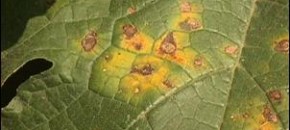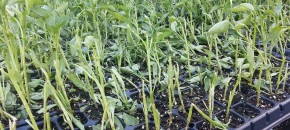Potato Strawberry Tomato Potato Blackleg is caused by Erwinia spp. which also cause ‘soft rots’. The bacteria which lead to the aerial phase of Blackleg are soil-borne (originate from old crop debris) and spread by rainfall, overhead irrigation and wind.
Continue reading...Recognizing Angular Leaf Spot in Cucurbits

Angular leaf spot is common in New Jersey and the region. It often shows up during cool, wet weather and isolated rain. Angular leaf spot will first appear as, small water-soaked lesions which will expand until they reach a larger leaf vein resulting in the angular looking symptoms on leaves. Under heavy disease pressure, the bacteria will […]
Continue reading...Controlling Phytophthora Blight in Pepper
With the wet weather, conditions for the crown rot phase of Phytophthora blight have increased. Phytophthora blight typically develops in low-lying areas of fields after a heavy rain and can spread quickly throughout the entire field. Planting on a ridge or raised, dome-shaped bed will help provide better soil drainage.
Continue reading...Severe Hail in Southern New Jersey

On Thursday night areas of southern New Jersey were hit with severe hail. A significant amount of damage was done on all crops across a few of counties (Salem, Gloucester, and Cumberland).
Continue reading...Controlling Emerged Palmer Amaranth in No-Till Burndown
I have observed a lot of emerged Palmer amaranth seedlings. Early planted corn should be scouted at 4 weeks after planting to determine if a POST herbicide application is needed. A lot of no-till soybean fields need a burndown herbicide, and if Palmer amaranth is present in those fields, it makes things challenging. If the […]
Continue reading...Potato Disease Forecasting Report 5-23-14
Potato Disease Forecasting Report 5-23-14 – Click to Download We will be tracking DSVs for Late blight development and calculating P-days for initiating the first early blight fungicide application. The first late blight fungicide application is recommended once 18 DSVs accumulate from green row. Green row typically occurs around the first week in May in southern […]
Continue reading...